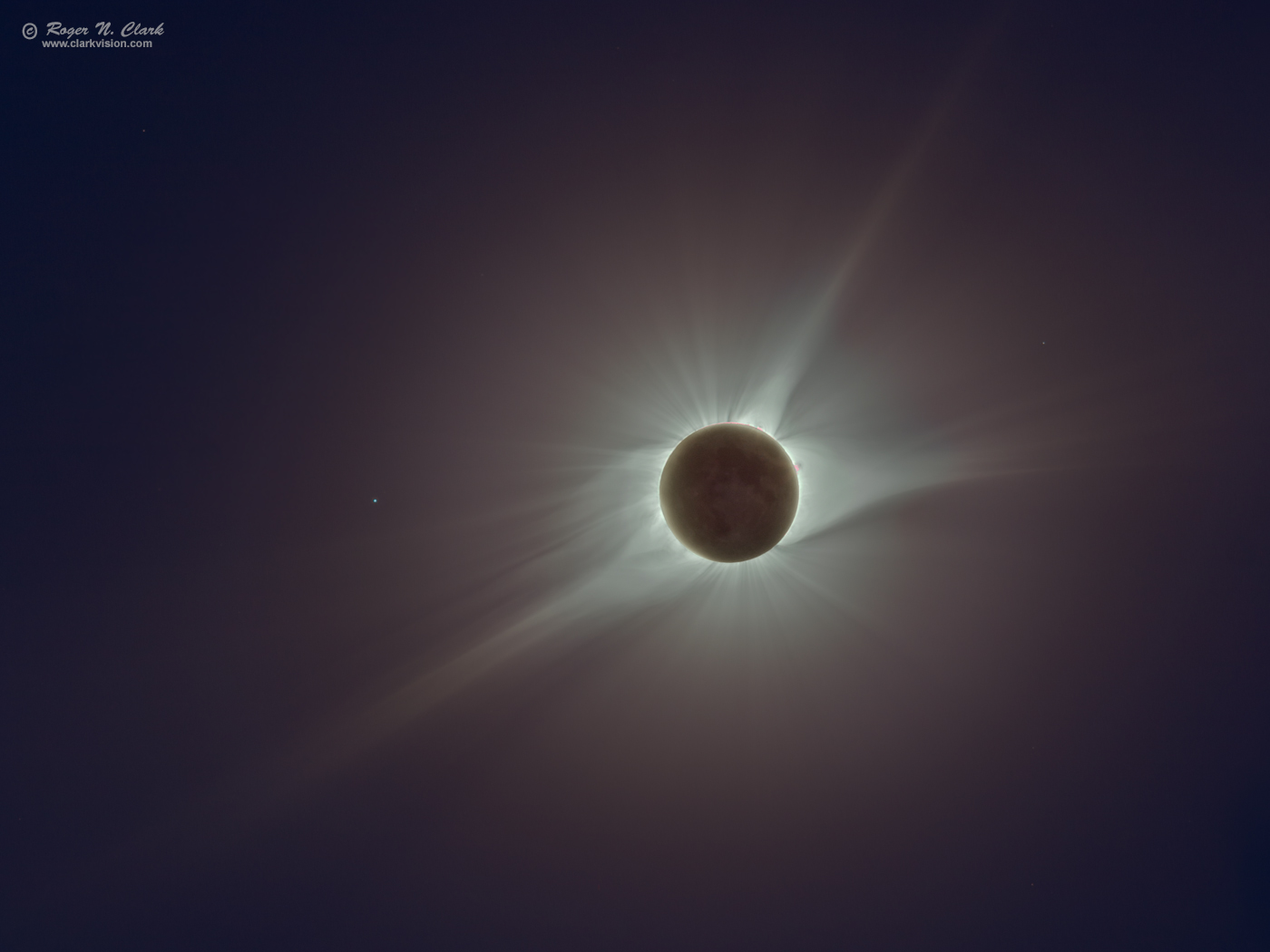| Home | Galleries | Articles | Reviews | Best Gear | New | About | Contact | Gallery Index | Previous |
Next |

| Home | Galleries | Articles | Reviews | Best Gear | New | About | Contact | Gallery Index | Previous |
Next |

The August 21, 2017 total Solar Eclipse provided an astonishing view for those in the zone of totality. Everyone should see such a sight at least once in their lifetime. This view, captured by multiple exposures shows more and fainter detail than I could see unaided eye. The pink prominences were visible in small telescopes. The structure in the corona is mainly due to charged particles in the Sun's magnetic field. If your monitor is well calibrated, the color of the corona should look greenish-gray. The bright star to the left is Alpha Leo, Regulus. Regulus is a hot star and looks bluish.
The green color is caused by iron XIV "Coronium" emitting at 530.3 nm in the green. The pink-magenta color in the prominences is due to hydrogen emission (Hydrogen-Alpha at 656.3 nm in the red, Hydrogen-Beta at 486.1 nm, blue-cyan, and Hydrogen-gamma at 434.1 nm in the blue). The orange color is from light scattered off of dust in the F-corona. The F-corona is a continuation of the zodiacal light seen in the night sky near dawn and after sunset.
Technical. The corona seen during a total eclipse has a very high dynamic range. Multiple exposures were needed by a camera to cover that range. Sixty images were combined to make this image. I used Canon 6D 20-megapixel digital camera, with a 1.4x teleconverter and a Canon 500 mm f/4 telephoto lens on a fixed tripod. Exposures: 7 frames at 1/8 second, 3 frames at 1/25th second, 5 frames at 1/80 second, and 2 frames at 1/250 second, all at f/11, ISO 200. The second camera was a Canon 1D Mark IV with a Canon EF 200mm f/2.8L II USM Lens. Exposures: 12 images at 1 second, 13 images at 1/4 second, and 18 images at 1/16 second, all at f/4, ISO 200. Total exposure time was 17.44 seconds covering an exposure dynamic range of 2000, or about 11 stops. Combined with the camera dynamic range of 11 stops, over 20 stops in light level was imaged. The multiple frames at the same exposure were aligned and stacked with sigma-clipped average and saved as 32-bit floating point images. Then each stacked image had a radial blur applied and 75% of the blur subtracted to enhance detail. Color correction were made at each step to show the colors that came out of the camera with some of the (blue) Rayleigh scattering in the atmosphere reduced but not completely removed. The different exposures were assembled and levels adjusted to give a consistent flow from bright inner to the very faint outer corona. Full plate scale was 1.04 arc-seconds/pixel with the 700 mm lens and 5.87 arc-seconds/pixel with the 200 mm lens. The image is reproduced here at 11.75 arc-seconds/pixel.
For more information on the color of the solar corona, see: True colors of solar corona by Miloslav Druckmüller
See How to Photograph the Sun: Sunrise, Sunset, Eclipses for more details on solar eclipse photography.
To learn how to obtain stunning images like this, please visit my Extensive Articles on Photography .
Keywords to this image = astrophoto-1 the_sun eclipse canon_6d moon
Image ID: solar-eclipse-total-rnclark-200+700mm.c08.21.2017.c-c2-0.5xs.jpg
| Home | Galleries | Articles | Reviews | Best Gear | Science | New | About | Contact |
Last updated December 20, 2025